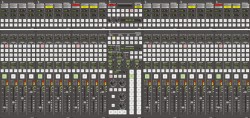A RM4200D mixer consists of two main parts, which are coupled via an industry standard CAN-bus connection (see figure 1-1 ). These parts are:
The DSP Frame.This unit includes all input and output modules, the DSP Audio Engine, the Control Engine and the power supply.
The Mixing Console.This is the user interface of the mixer with all faders, control knobs, push buttons and displays.
The mixing console has a modular design, which allows to combine different modules for different applications. All modules are linked to each other and to the DSP frame via CAN-bus cables. Modules can be located apart from each other, as long as the specifications for cable length and power supply are met. The total length of all CAN-bus cables may reach up to 60 meters.
There are two basic kinds of control modules – those containing faders and those without faders. A single fader module contains four separate faders, up to 40 faders can be used together in one single mixing console. If desired, the fader modules can be ordered with motor faders.
Several different fader modules are available, so are several different control modules. Although looking different, they can all be used to access any control function in the system. However, the number of functions a module can access simultaneously differs, depending on the actual module.
Almost all modules can be combined with each other in many possible combinations. This allows to “tailor” a mixing console to your special needs -— from simple self operation desks (figure 1-2 ) to full blown control room consoles with direct access to many functions (figure 1-3 ). However, as a user of a RM4200D system you are not limited to these traditional setups. Virtually any combination of control modules is possible. If your intended application has special requirements, please talk to your DHD sales representative.
Since all modules are coupled using CAN-bus cables, you can install them in your furniture at will instead of having the furniture built around a more traditional mixing desk. The installation depth for desk-mounted modules is only 72 mm.
The mechanical construction of all modules is designed to withstand 24/7 use. Sturdy components like Penny&Giles faders, Lumitas keys and Lexan foil covers on all front panels let the RM4200D perform for a long time.
The typical functions for a RM4200D mixing console include (but are not limited to):
Input routing, input processing, microphone processing and bus assignment.
Monitoring, talkback, signalling and On Air switching.
Providing clean feed/mix-minus signals and output routing.
Recalling and saving user-defined setup data for microphone processing and overall mixer setup. Setups are stored in internal Flash memory or on chip cards.
With the RM4200D it is possible to control many functions not only from the control modules but from external systems as well. This is especially useful when integrating the RM4200D with playout and automation systems. These can be connected via a serial interface, Ethernet or GPIO ports.
Some possible applications of this feature include:
Remote faderstart.
Remote triggering of PFL controls from the playout system.
Display of remaining time on top of currently open faders.
Of course there are many more applications possible. Please keep in mind, that the versatile design of the RM4200D might allow unconventional solutions to your problems, which often are not obvious. In these cases it pays off to consult the other parts of this documentation and to talk to your DHD sales representative. He might be able to help you to find the matching combination of RM4200D modules for your application.


